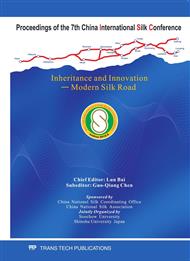p.192
p.197
p.202
p.209
p.214
p.220
p.224
p.230
p.236
Imine Bond Characterization and Properties for Controlled Release Drugs of Collagen Protein Cross-Linked Cotton Fiber
Abstract:
For exploiting the novel multifunctional ecological cotton fibers, a new cotton fiber with the collagen protein cross-linking (CPCCF) was prepared by the limited selective oxidation of a cotton thread with sodium periodate solution and subsequent treatment with a solution of collagen protein at 40°C in aqueous acetic acid. FT-IR spectra of the CPCCF suggested that the imine covalent bond between the collagen protein and the oxidized cotton fiber was formed through a series of reaction. X-ray diffractograms analysis showed that the crystallinity of oxidized cotton fiber after collagen protein treatment increased slightly. Meanwhile, Scanning electron microscopy photographs illuminated that the modification with collagen protein occurred on the surface of cotton fiber. Kjeldahl nitrogen analysis of the CPCCF showed that the maximum percentage of collagen protein introduced into cotton fiber was 1.68% (w/w). However, the breaking strength of the cotton thread oxidized partially by sodium periodate at the concentration of less than 2.0 mg ml-1 did not decrease much. Furthermore, a model experiment for the controlled release drugs was performed using aloe anthraquinone, components of a Chinese medicine, suggested potential usefulness of the CPCCF as a carrier for the controlled release drugs.
Info:
Periodical:
Pages:
214-219
Citation:
Online since:
January 2011
Authors:
Price:
Сopyright:
© 2011 Trans Tech Publications Ltd. All Rights Reserved
Share:
Citation:


